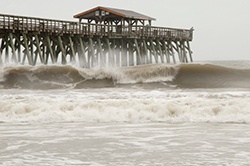 Hurricane Sandy hit New York City in October 2012 - flooding streets, tunnels, and subway lines and cutting power in and around the city. But we at Gibson are located in the Midwest. Chicago did issue flood warnings as wave heights were expected to reach 18-23 feet. In Michigan, some schools closed due to power outages. But here in Indiana, we weren’t affected. Or were we?
Hurricane Sandy hit New York City in October 2012 - flooding streets, tunnels, and subway lines and cutting power in and around the city. But we at Gibson are located in the Midwest. Chicago did issue flood warnings as wave heights were expected to reach 18-23 feet. In Michigan, some schools closed due to power outages. But here in Indiana, we weren’t affected. Or were we?
Until Hurricane Sandy hit New York City, the primary location of our phone vendor. And while they had multiple fail-safes in place, you guessed it – those failed. They lost power, which should have been a non-issue, except their generator was under water. The rollover system they had in place to get their customers over to one of their redundant systems also failed. We found ourselves unable to use our phone system to connect with our customers for 2-3 days. We didn’t shut our doors. We didn’t lose customers. But we did have to scramble to put a solution in place.
This is one of many examples of how a severe weather event outside your region can still affect your organization. Hurricanes, wildfires, droughts, tsunamis, earthquakes, tornadoes – there are several forms of severe weather that are more common to specific geographic areas. But their impact is can often be felt much further.
No, Indiana is not going to experience the eye of a hurricane, but those in the Midwest are not immune to the effects of hurricanes. On the West Coast you are not free from the aftermath of tornadoes. Throughout the East Coast, you are not exempt from the impact of a drought or wildfires in California. These types of disasters can hit your suppliers, vendors, and key partners – and in turn affect your organization.
It is critical not to cast aside these types of incidents when preparing your disaster recovery plan.
So what can you do?
As part of your business continuity planning, think about the vendors you rely upon. Talk through the ‘what ifs’ and possible scenarios. Where are they located? What kind of disaster may they be susceptible to? Are there backup vendors you might be able to turn to in an emergency?
Discuss with your vendors what their disaster plan is. What measures do they have in place to try to prevent disruption to your service? PrepareMyBusiness.org offers a resource for conducting a vendor assessment.
Pay attention to weather trends and stay in the know. Though some severe weather events strike with little warning, others develop more slowly, providing you with time to put your plan into action.
Next time you hear about a severe weather event threatening cities hundreds or thousands of miles away, don’t just click off the news. Think about how it could impact your vendors, suppliers, and key partners. Look back at your business continuity plan and adjust accordingly to make sure your organization has a response planned. This is a critical aspect of being #DisasterReady.




